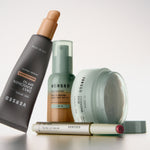Despite earning its reputation as a holy grail item in the skincare universe—known to fend off aging, smooth pores, clear breakouts, and more—the do’s and don'ts of retinol have caused many to shy away from it in fear of inadvertently using it incorrectly. Retinol is a powerful ingredient and it is true that most of its products should be handled with care, but let us put you at ease: there are many options that can still deliver visible results without the rumored side effects.
Keep scrolling for your complete guide to where, when, and how often to use retinol and retinoids.
When to Start Using Retinol
Don't wait until you start seeing fine lines and wrinkles. Retinol—and any products for aging skin, really—can be added to a skincare routine at any age as a defense mechanism against premature damage. Plus, retinol isn't only beneficial for signs of aging; it can reform bumpy skin texture, treat acne, and repair dark spots and hyperpigmentation.
How to Use Retinol
There are many different types of retinol with a wide range of potencies. It's important to follow the instructions on a product's packaging for proper application and to avoid irritating the skin.Since retinol speeds up cellular turnover (leaving your fresh, renewed complexion more sensitive to the sun), it is best applied at night on clean skin. And don’t forget to apply sunscreen in the AM to protect those new skin cells.
How Often to Apply Retinol
Traditional retinoids can be too potent (a.k.a. drying and irritating) to use more than a few times a week, particularly if you have sensitive skin. Our Gentle Retinol Serum, however, can be used every single night (yes, even if you’re new to retinol) because it’s formulated with encapsulated retinol (which bypasses the surface of skin, where the irritation occurs) and plant-based alternatives that are much gentler on the skin.
If you are super cautious about retinol, doing a patch test to see how your skin reacts never hurts. 
Where to Apply Retinol
Your face, of course, but also your neck and chest. Because the skin around your décolletage is thin, it tends to show signs of aging quickly. Some eye creams and balms contain gentle forms of retinol to help smooth crow's feet, too.
On that note, don't forget about the rest of your body. Smooth on a Retinol Body Lotion to get similar results (firm, soft, and glowing skin) for the neck down.
How Long Does Retinol Take to Work?
With retinol (or any repairing ingredient for that matter), consistent application is key. It can take around 1-3 months to see visible changes for signs of aging and overall skin clarity, but everyone's skin is different. For better results, make sure you apply ample sunscreen in the AM.
Will Retinol Cause My Skin to Purge?
It could. Retinol promotes a faster skin cell turnover, which can push dead cells—along with any sebum and pore-clogging buildup—to the surface and cause breakouts. Not everyone will experience purging with retinol but if you do, know that it should subside in about a month.What Ingredients Can I Combine Retinol With?
Technically, the only ingredient that doesn’t mix well with retinol is benzoyl peroxide, because the two ingredients actually counteract each other. But we also advise against layering retinol and vitamin C (unless they’re formulated together in the same product) to avoid any potential irritation or sensitivity. We also suggest waiting 24 hours after dermaplaning before applying any retinol-based products. If you're using Press Restart, opt to use the following products during your morning routine or save them for another night:- Weekend Glow
- Doctor's Visit
- Stroke of Brilliance
- Vacation Eyes
- Found the Light
- The Shortcut
- Instant Gratification









